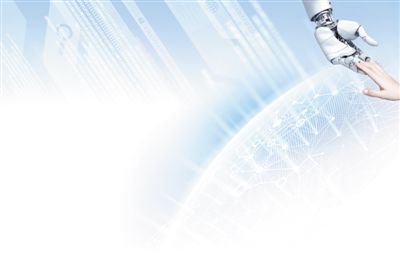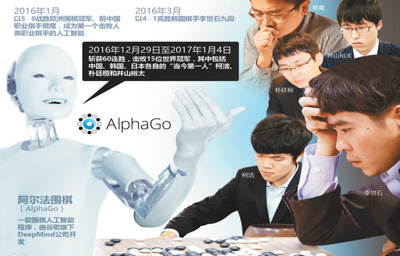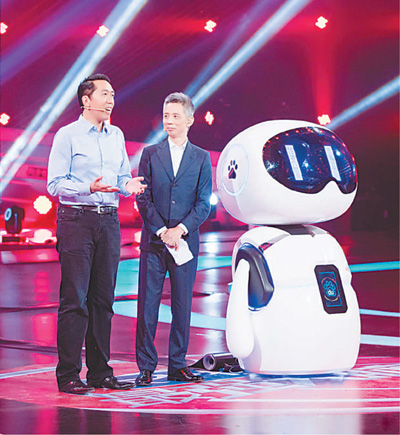International Vision: Is the Singularity Moment of Artificial Intelligence Approaching?


On January 5th, 2017, Master (later admitted to be Alpha Go) won 60 consecutive victories against top players from China, Japan and South Korea, including Ke Jie, Park Junghwan and Yuta Iyama.

In April 2015, British scientists invented the robotic arm, which can cook skillfully and reach the world-class level in cooking.

Artificial intelligence is generally considered to generate a computing system with human-like intelligence by simulating, extending and expanding human intelligence. Its concept was put forward in 1956 and experienced ups and downs for 60 years. With the development of hardware, software, big data, deep learning and other technologies to a certain level, artificial intelligence began to develop in a blowout manner, and suddenly became hot from a long-term tepid state.
Artificial intelligence helps humans improve work efficiency and quality of life. However, while being happy with the development of artificial intelligence, we should also rationally face the challenges posed by artificial intelligence to human beings.
New tipping point of technology and industrial revolution
From 1956 to 2016, artificial intelligence was 60 years old. Why is it that at this moment, "old people talk about teenagers", which stands out from a number of emerging high-tech?
Luke Domell, an American writer, put forward the concept of "singularity" in his book Artificial Intelligence. Singularity refers to the point where machines surpass human beings in intelligence. At present, artificial intelligence is approaching the "singularity moment" in both technology and industry.
First, the information revolution is deepening from technology to science and upgrading to intelligence, and artificial intelligence is at the singularity of the scientific and technological revolution. The information revolution originated from the information technology revolution. Computer, communication network, Internet, cloud computing, Internet of Things … … They represent different parts of the elephant of the information technology revolution. Until the development of big data, the whole picture of the elephant of information technology began to appear from a scientific height. Artificial intelligence based on data science represents a qualitative leap from information technology to information science, and develops information technology to the height of information science for the first time.
If the essence of wisdom is "easy to deal with change", then artificial intelligence combines rationality and sensibility to deal with "change" as easily as human beings. In order to summarize the essence of Industry 4.0, ulrich Sendler, an expert of German Industry 4.0, combined the English word "simplicity" with "complexity" and created a new word "simplicity", which means to make complexity easier. With the development of artificial intelligence for 60 years, we have been exploring the specific methods of "easily coping with changes". Traditional artificial intelligence in the 1950s was too superstitious about rational algorithms. It was not until the "perceptual" method of neural network became popular in the 1980s that a method to deal with irregular things was found. After 2006, deep learning with both rationality and sensibility has become the new mainstream of artificial intelligence. In 2016, mankind finally ushered in an important moment of artificial intelligence. In March, 2016, the computer program of Google Go, using the Monte Carlo algorithm combining sensibility and rationality, beat Li Shishi, the world champion and Korean chess player, with a score of 4∶1. The victory of Alpha Go marks the arrival of an important singularity moment of artificial intelligence, which is becoming the tipping point of the next generation of technological revolution.
Second, the information revolution is transforming from science to technology and deepening to the smart industry, and artificial intelligence is at the singularity of the industrial revolution. The information revolution is mature in the industrial revolution. The singularity of technological revolution gave birth to the singularity of industrial revolution. The technological revolution took the lead in detonating industrial automation, medical health and other fields, making artificial intelligence develop rapidly in the direction of marketization and industrialization.
Taking smart cars as an example, automotive electronics have accounted for 40% of the total vehicle cost. If the proportion of intelligent contribution in automobile parts and added value exceeds 50%, the automobile will undergo qualitative change and reach a singularity. Once the proportion of all industrial intelligence exceeds 50%, the singularity moment of industrial intelligence will come. Driverless cars can cope with the complex actual driving environment by loading forward-looking cameras, forward-looking radars, lidar, high-precision maps and many intelligent technology equipment.
For the development of modernization
Replace the "engine"
At present, among the 31 developed economies, the growth of 30 economies has slowed down, and the average annual growth rate from 1994 to 2004 has dropped from 2% to 1%. The relatively rapid development of the United States, the growth rate has also dropped from 2.3% in the previous decade to 1.1% in the next decade. Industrialization The kinetic energy provided by this engine is getting weaker and weaker. Driving modernization with two engines of industrialization and informationization has become a new way for people to find since the international financial crisis in 2008.
The greatest significance of developing artificial intelligence is to replace the "engine" for modernization. Accenture, a consulting firm, studied 12 developed countries, including the United States, Finland and Britain, and found that by 2035, artificial intelligence will help these countries increase their productivity by about 40%. Among them, the countries with the largest increase in artificial intelligence productivity are Sweden, Finland, the United States and Japan.
In the current field of artificial intelligence research, the United States has played a leading role. During the Obama administration, the President’s Office issued "Preparing for the Future of Artificial Intelligence" and "National Artificial Intelligence Research and Development Strategic Plan". In the previous report, the former Obama administration called for giving priority to basic and long-term artificial intelligence research and formulating policies for developing automatic and semi-automatic weapons. The report proposes to establish an institution similar to the National Defense Advanced Research Projects Agency to support high-risk and high-return artificial intelligence research and application; It is suggested that federal agencies should give priority to opening training data and data standards in the field of artificial intelligence; It is suggested that the US Department of Transportation should constantly improve the regulatory framework and integrate fully automatic vehicles and drones into the transportation system safely. The second report puts forward seven strategies: investing in the field of artificial intelligence research and development for a long time, developing effective methods of man-machine work, understanding and dealing with ethical problems brought by artificial intelligence, ensuring the safety of artificial intelligence drive system, sharing public data sets and environment for artificial intelligence training and testing development, establishing standards and benchmarks for evaluating artificial intelligence technology, and deeply understanding the national demand for artificial intelligence R&D talents. According to the plan, in 2015, the federal government invested about $1.1 billion in artificial intelligence related technologies. According to the statistics of professional data analysis platform, as of the beginning of 2016, there were 957 artificial intelligence companies in the world, including 499 American companies, accounting for more than 50%.
In addition, other developed countries have also invested in the development of artificial intelligence. Japan focuses on reducing costs, strengthening intelligent manufacturing capabilities and increasing investment in artificial intelligence. On August 11, 2016, the Japanese government wrote the contents of inter-departmental policies related to artificial intelligence into the second supplementary budget for 2016. Some policies will be written into the 2017 government budget application and will continue to be supported. Japan uses artificial intelligence in manufacturing to improve productivity and overcome the shortage of manpower to meet the challenge of social aging. Japan has also given preferential tax system, preferential loans, tax reduction and other policy support to enterprises that develop artificial intelligence technology.
The EU takes the "Human Brain Project" as the flagship project of emerging technologies in the future, focusing on data research. The "Human Brain Project" attaches great importance to grasping technology from the commanding heights of science and brings together nearly 300 experts in the fields of neuroscience, medicine and computer. By 2023, this project will cost 1 billion euros. Germany pays attention to scientific research and development and the transformation of technological achievements, ranking fourth in the world in the number of patents applied for artificial intelligence, but it has expertise in robotics, neural networks, speech recognition and image recognition. German artificial intelligence research center studies artificial intelligence technology, such as automatic driving, speech recognition, image recognition, machine learning, intelligent robot human tracking and other fields, and carries out scientific research and development and transformation of technological achievements. The cumulative contribution of academic achievements and scientific research projects every year exceeds 480 billion euros.
Can "Frankenstein complex" be solved?
In the short term, artificial intelligence promotes economic automation and social intelligence. Artificial intelligence improves the level of automation, thereby enhancing productivity and accumulating a lot of wealth. But whether automation affects employment has become the focus of controversy. Because there is a big wage gap between Chinese and American workers, American capitalists would rather replace workers with automation than increase employment. The latest report of Forrester Research shows that artificial intelligence will reduce the number of jobs in the United States by 6% in the next five years. In fact, it is not inevitable that artificial intelligence will reduce employment. Different from replacing people with machines in automation, artificial intelligence platform can access a large number of value-added applications (APPs) through application interfaces (APIs), which can create a wide range of flexible employment opportunities for developers. Alibaba Cloud Research Report proposes that under the trend of artificial intelligence platformization, artificial intelligence will present a competitive pattern of several leading platforms and a wide range of scenario applications in the future. Developing a large number of subdivided scenario applications through APP developers will activate flexible employment more effectively than automation.
Artificial intelligence has outstanding performance in intelligent transportation, smart home and wireless city. The new flexible robot can cook and wash dishes, make the bed, wash clothes and walk the dog. Artificial intelligence can also help you choose clothes and decide what to eat for dinner. Virtual reality, augmented reality and mixed reality combined with artificial intelligence can already replace real-life tour guides. In the future, urban traffic will also be improved by artificial intelligence. The Automobile R&D Center of Honda Institute of Technology in Japan has developed a new technology that uses artificial intelligence to predict traffic congestion. This technology uses smart phones as sensing devices, and matches the driving data such as car speed, acceleration and deceleration with the congestion degree of surrounding roads to improve traffic conditions.
In the long run, artificial intelligence will drive the economy to transform into a service-oriented and high-end direction and drive the society to transform into a flexible and intelligent direction. Change is differentiation, and differentiation corresponds to high-end demand value and service on supply. The main economic effect of industrialization and automation is that the more differentiated the demand, the higher the average cost of differentiated supply, while artificial intelligence achieves the opposite economic effect to industrialization, that is, the more differentiated the demand, the lower the average cost of differentiated supply.
With the help of artificial intelligence, this differentiation can be achieved at low cost through mass customization. That is to say, in the form of small batch and many varieties, it will be upgraded to the direction of service and obtain stable and high added value. Future news can be contextualized, and the cost of contextualization can be reduced through personalized recommendation+intelligent computing+context awareness. Future advertisements can be accurate advertisements, which can judge the consumption intention and deliver accurately according to the context of consumers; Future personal health data can be recorded through wearable devices, and with the help of big data analysis, personalized services of 24-hour medical care and diagnosis and treatment can be realized. In 2016, the University of Tokyo in Japan used Watson artificial intelligence technology of International Business Machines Corporation. It took only 10 minutes to diagnose a 60-year-old woman with a rare leukemia and provided a low-cost personalized diagnosis and treatment plan.
Human beings have always had a Frankenstein complex about the security of artificial intelligence. Frankenstein, a novel by mary shelley, a British novelist, tells the story of a science student who created a scientific creature, which eventually became a murderer. Will artificial intelligence go against human beings after surpassing human intelligence? Ray kurzweil, president of Singularity University in the United States, predicted that this singularity would appear in 2045. But Domell, the author of Artificial Intelligence, thinks that it is not whether human beings can design something better than themselves, but what the policy is and what people decide to do with technology. In September, 2016, the British Standardization Association published the Guide to Ethical Design and Application of Robots and Machine Systems, hoping to take the guide of robot ethics as a breakthrough and explore ways to avoid such risks. At present, governments and enterprises all over the world pay more and more attention to this problem.
How to supervise the negative problems brought about by the development of artificial intelligence is a topic of general concern to the international community. Former US President Barack Obama believes that in the early development stage of artificial intelligence, the regulatory framework should be in full bloom. The government should intervene as little as possible and invest more in scientific research to ensure the transformation between basic research and applied research. With the development and maturity of technology, how to bring it into the existing regulatory framework is a more difficult problem, which requires governments to participate more in exploration.
(Jiang Qiping is the Secretary General of the Information Research Center of China Academy of Social Sciences)